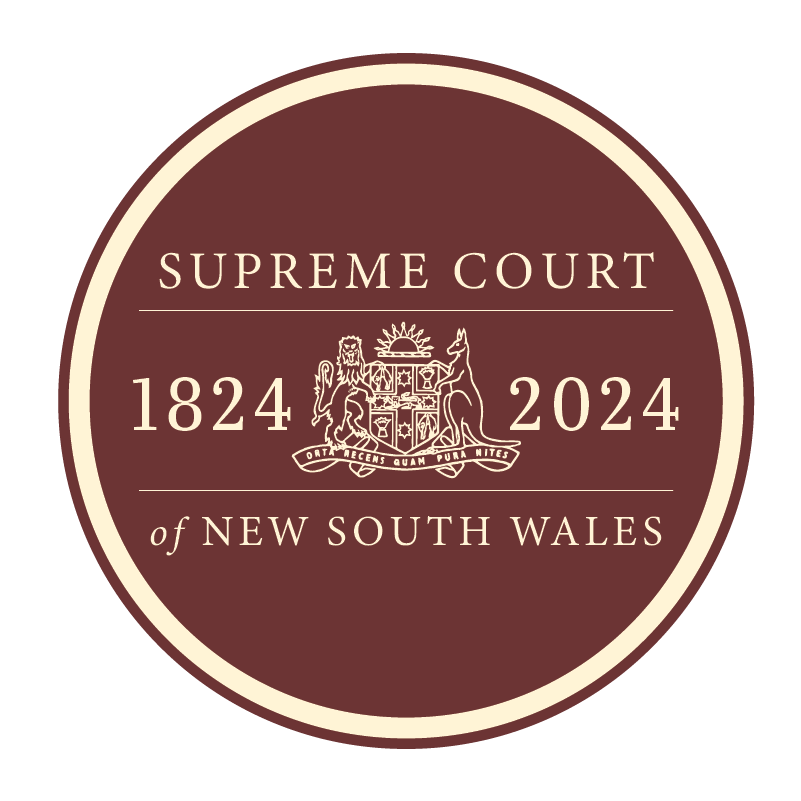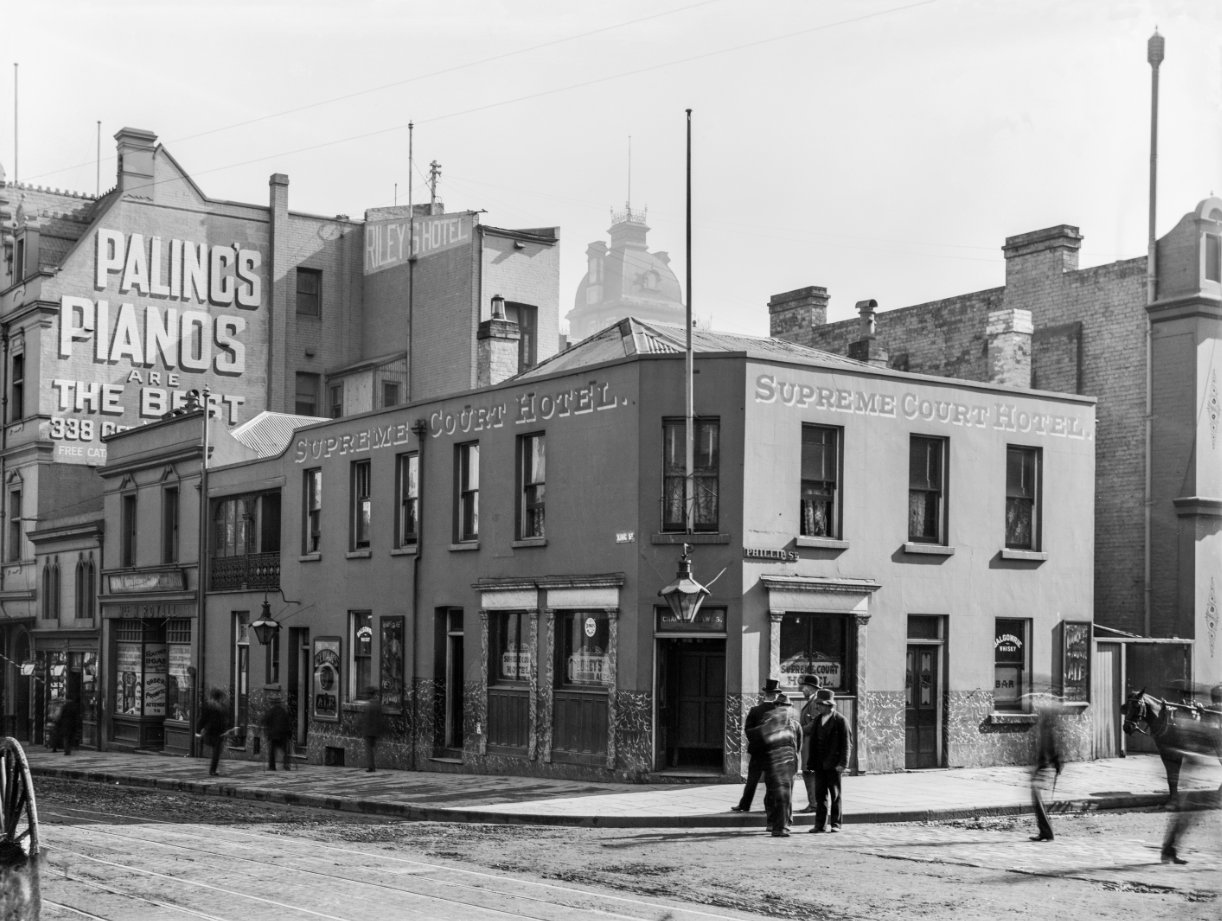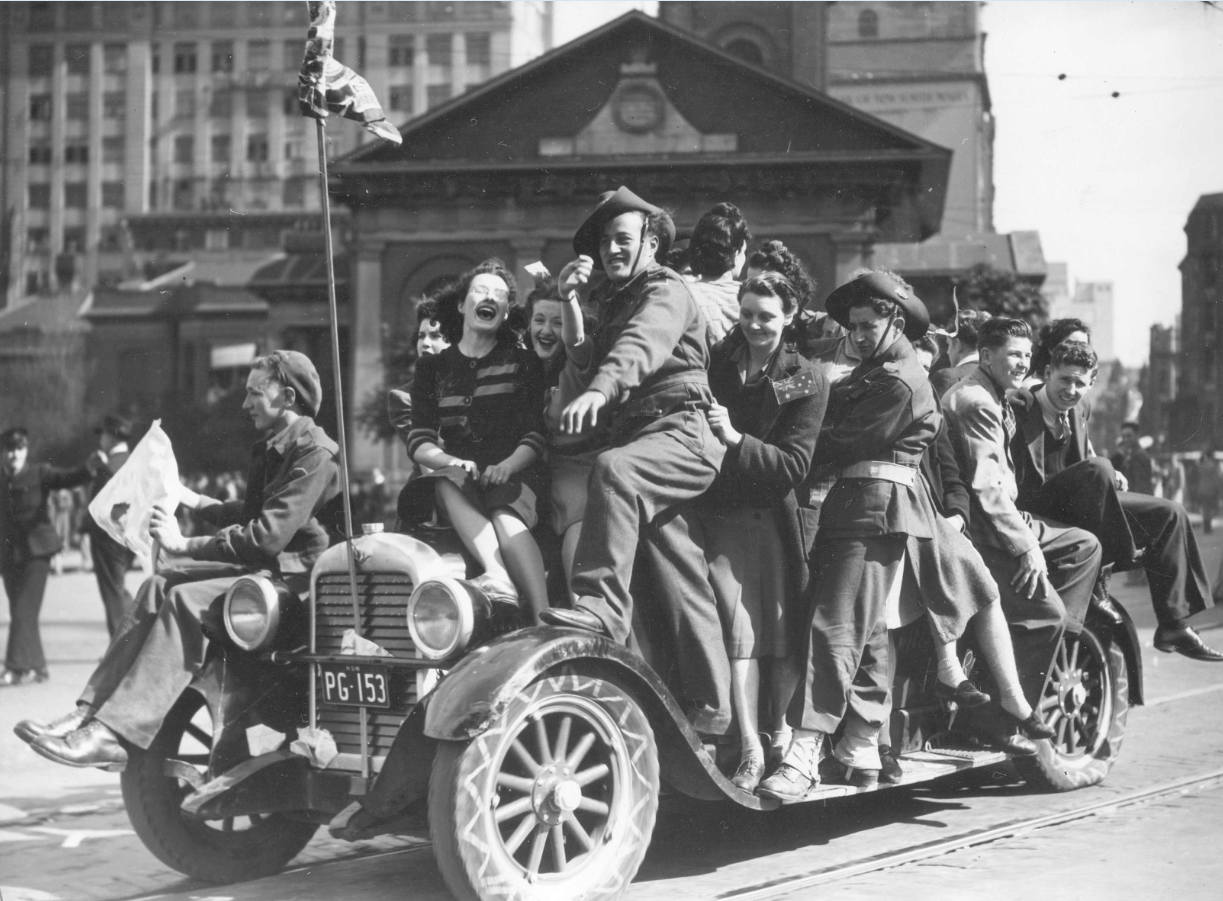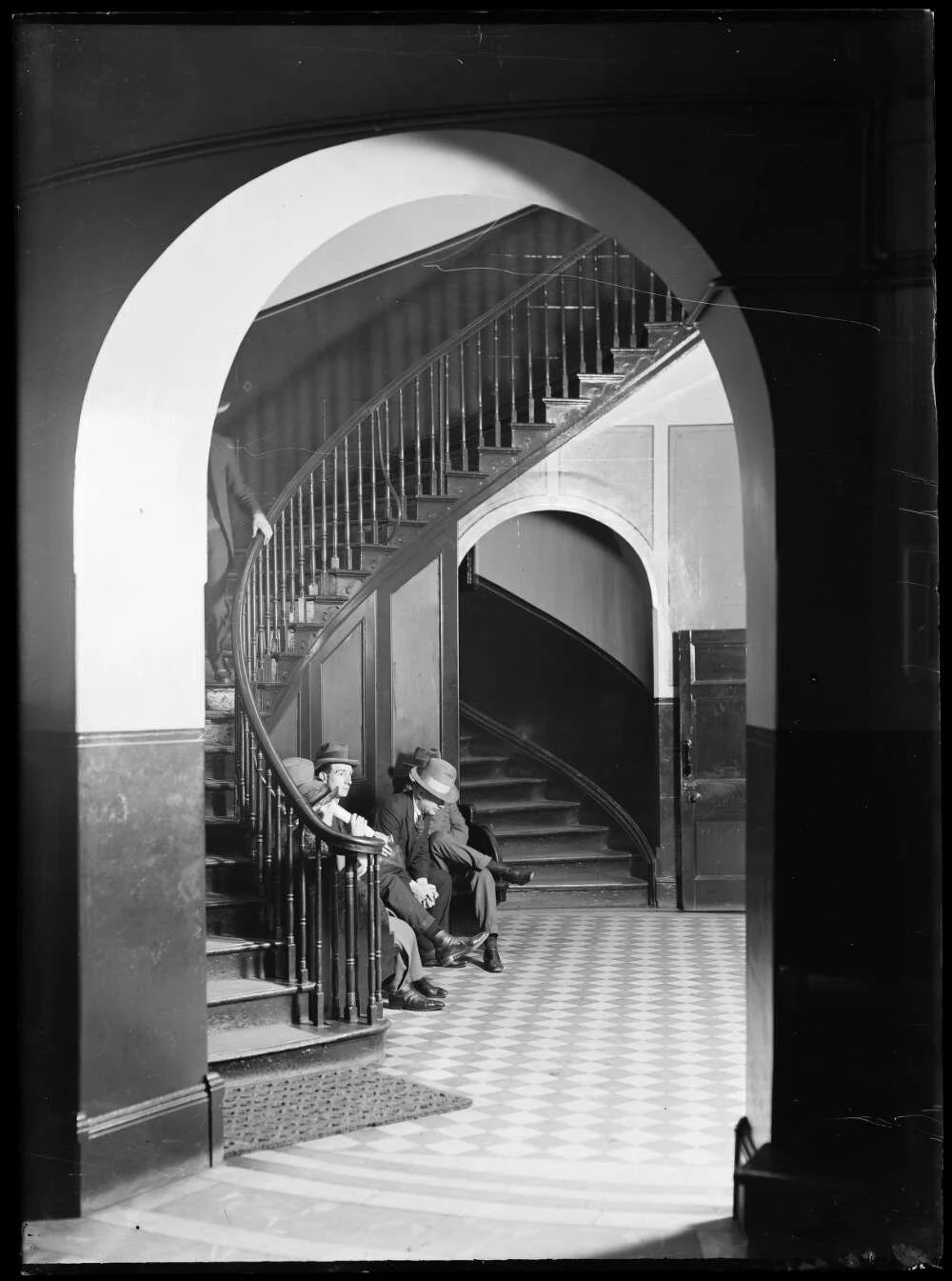Print on chromaluxe
c.1930s
Supreme Court on King Street
Max Dupain
Max Dupain AC OBE (1911 – 1992) was an Australian modernist photographer. Throughout his life, Dupain photographed the Supreme Court from the 1930s until the late 1970s. His work shows the transformation of the cityscape over the early 20th century.
The King Street Court Complex was designed by colonial architect Francis Greenway in 1819, with construction being completed in 1828. The building was occupied by the Supreme Court until construction of a new Banco Court on St James Road. Today, it is heritage listed and forms a major part of the judicial hub in Queens Square.
Percy Coleman outside the Supreme Court wearing a wig and gown, NSW.
F. S. Grimes
From the Fairfax Media Archives collection.
Percy Edmund Creed Coleman (1892 – 1934) was a union organiser and politician. In the 1932 NSW State election he lost only by a narrow margin to Jack Lang. After his defeat, Coleman was admitted to the NSW Bar in 1933, but soon took up the post of NSW (federal) ALP President. He died suddenly in his car a year after this photograph was taken.
Print on chromaluxe
1933
Print on chromaluxe
1901
King Street on a rainy day
Unknown artist
From the State Library of NSW collection, this photograph depicts an east-bound view of King Street from the corner of Elizabeth Street on a rainy day.
Named after Governor Phillip Gidley King, King Street runs through the Sydney central business district from the Wharf on Darling Harbour in the west to Queen’s Square in the East. At the time this photograph was taken, the street was home to notable colonial structures including Greenway Wing (King Street Court Complex) and St James Church, both of which can be seen to the right of the photograph, and remain structurally-intact and heritage-listed today.
Today, King Street has seen significant development with the construction of the Law Courts Building in Queens Square but it remains home to the legal profession in Sydney.
Daguerreotype, print on chromaluxe
1927
Ada Norton
Unknown artist
Photograph negative is held by the State Library of Western Australia. In 1916, Ada Norton became one of the first women to successfully claim her abusive late husband’s estate using the backdated Testator’s Family Maintenance (TFM) Act 1912. When member of the Legislative Assembly John Norton died in 2016, his estate was valued at 106,000 pounds. His will excluded his wife Ada, whom had brought divorce proceedings against him one year earlier on the grounds of habitual cruelty and adultery. She brought a claim for the estate under the Testator’s Family Maintenance Act and was among one of the first successful applicants under the Act.
Print on chromaluxe
c.1900s
Supreme Court Hotel
Unknown artist
Described in the City of Sydney Archives this images shows ‘a group of men chat on the corner of King and Phillip streets outside the Supreme Court Hotel. The hotel was opposite the old Supreme Court building on the corner of King and Elizabeth streets, now referred to as the King Street Courts. There's a painted advertisement on the wall of a three-storey building further along King Street: 'Paling's Pianos Are The Best 338 G'. Another building has a painted sign for 'Riley's Hotel'. The cupola of Hotel Australia can be seen in the distance.’
THE WAR IS OVER - Victory celebrations in Sydney
Unknown artist
The photograph captures the celebrations in Sydney on 15 August 1945, the day imperial Japan surrendered in World War II. Soldiers and civilians alike, such as those pictured in this photograph, took to the streets of Sydney to celebrate the end of the war.
Gelatin silver on chromaluxe
1945
Photograph of Archibald Fountain in Hyde Park, Sydney, named after the owner and editor of the Bulletin Magazine J. F. Archibald who bequeathed funds to have it built. The fountain was designed by Frech artist Francois-Leon Sicard who completed its design in 1926. Its design was inspired by classical Greek and Roman architecture, and it bears inscriptions and sculptures of classical figures.
Print on chromaluxe
c.1930s
Archibald Fountain in Hyde Park
Unknown artist
Justice Sir Laurence Street - Chief Justice of NSW - Personality
Michael Rayner
Print on chromaluxe
1988
Sir Laurence Street, who served as tenth Chief Justice, and Lieutenant-Governor, of New South Wales was the third generation in the prominent Street family to serve in judicial and political positions. He was the son of Sir Kenneth Street and the grandson of Sir Phillip Street, both of whom served as Chief Justice and Lieutenant-Governor during their careers. During his time Sir Laurence practised extensively in equity, commercial law and maritime law, pioneered alternative dispute resolution and worked prolifically in mediation. He retired from the Bench in 1988.
Men waiting under the staircase in the Supreme Court
Unknown artist
Photograph of men waiting under the staircase in the King Street Court Complex, Sydney, ca. 1930s. The photograph depicts the distinct geometric floor pattern and circular staircase which remain intact and prominent features of the building today.
Print on chromaluxe
c.1930s
Sir Frederick Jordan - Lt. Governor of N.S.W., 1934
Unknown artist
Print on chromaluxe
1935
The photograph taken 1935 depicts Sir Frederick Jordan, Chief Justice of New South Wales from 1934 to 1949. Prior to his appointment, Sir Frederick Jordan was a senior equity barrister but had not sat as judge. During his time as Chief Justice, the court underwent difficulties prompted by the Second World War, including a shortage of resources and manpower. Jordan’s administrative skills ensured the successful operation of the court through this period, and he earned the reputation as a Chief Justice whose pronouncements on the law were succinct, commanding and technically refined.
Print on chromaluxe
1985
Sir William and Lady Cullen
Unknown artist
Sir William Portus Cullen, leading Australian barrister and seventh Chief Justice of New South Wales, photographed by Elaine Pelot Syron alongside his wife Lady Cullen in 1985. Lady Cullen was an accomplished figure in her own right, as the founding vice-president of the New South Wales division of the British Red Cross and president of the Australian Red Cross Society. She was also president of the Victoria Leaue, vice-president of the Bush Book Club of New South Wales of New South Wales and chief commissioner of the State’s Girl Guides’ Association.
Mrs Sibyl Enid Morrison walking past 149 Philip Street
Unknown artist
Photographic print of Mrs Sibyl Enid Morrion, first female barrister in New South Wales, walking past 149 Philip Street with colleagues in the 1920s. Morrison graduated from the University of Sydney’s law school in 1924. During her studies, she witnessed the prejudice against women in the legal profession. After her admission to the Bar, she successfully established herself and was often briefed by pioneering female lawyers.
Print on chromaluxe
c.1920s
Print on chromaluxe
c.1931
Street Family
Unknown artist
Sir Philip Street, Lady Street, Mr Justice Kenneth Street and Mr E.W. Street in Justice Kenneth Street's office, New South Wales, ca. 1931
Sir Phillip Street was prominent judicial figure in New South Wales in the late nineteenth and early twentieth centuries. He was sworn in as judge of the Supreme Court in 1907, and after stints as deputy president of the Court of Arbitration and as chief judge in Equity, he served as Chief Justice of the Supreme Court from 1925 to 1934. In 1930, he was commissioned as Lieutenant -Governor. His wife Lady Street was a diplomat and Australia’s first female delegate to the United Nations where she campaigned for the inclusion of gender as a non-discrimination clause in the United Nations Charter.
Their son, Sir Kenneth Street also served as Chief Justice of the Supreme Court and Lieutenant-Governor of New South Wales. His ascension to the Supreme Court in 1931 marked the first time a father and son had presided over the same Australia court.
A silver gelatin reproduction of King Street c.1900. It depicts the busy street before the development and modernisation that we are familiar with today.
Silver gelatin (reproduction)
c.1900
King Street on a busy day
Unknown artist














